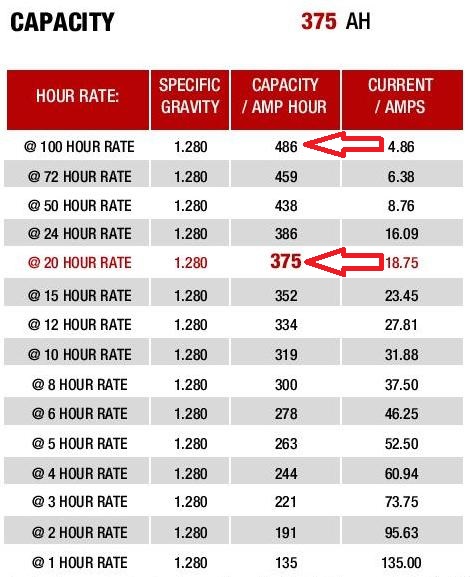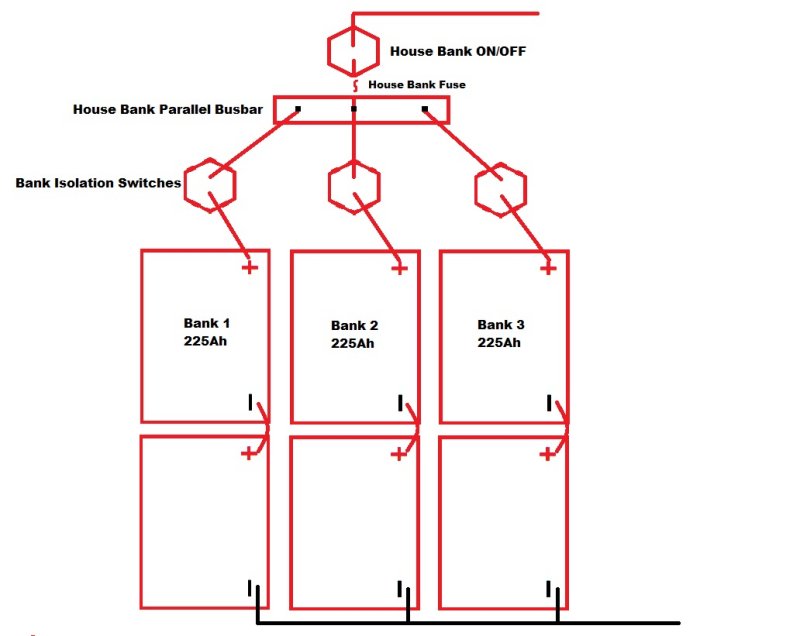Regarding Maine Sail's observation. Yes, I understand that three batteries is overkill. But they are already in place ....
It's not the
physical amount of batteries, heck for most 36' vessels two G-27's are pretty slim by today's standards, it is how they are wired or used as
banks. You have
three individual banks and that really serves no benefit on a boat that does not have a "bow bank". It's really hard to even justify a bow bank on most sub 42' vessels thus most sub 42' sailboats are going to be better served by two
banks. A contiguously wired house bank and a start or start/reserve.
I have posted this before but it is still relevant here:
IS IT BETTER TO HAVE ONE OR TWO BATTERY BANKS FOR HOUSE USE?
First here's Nigel Calders take..
Begin Quote = Nigel Calder
"The popular arrangement of having two house banks alternated in use needs scrutiny before I go any further.
LIFE CYCLES: As we have seen, the life expectancy of a battery in cycling service is directly related to the depth to which it is discharged at each cycle - the greater the depth of discharge, the shorter the battery’s life.
This relationship between depth of discharge and battery life is NOT linear. As the depth of discharge increases, a battery’s life expectancy is disproportionately shortened. A given battery may cycle through 10% of its capacity 2,000 times, 50% of its capacity 300 times and 100% of its capacity around 100 times.
Let’s say, for arguments sake, that a boat has two 200-ah battery banks, alternated from day to day, with a daily load of 80 Ah. Each bank will be discharged by 40% (80 Ah of one of the two 200 Ah banks) of its capacity before being recharged. The batteries will fail after 380 cycles, which is 760 days (since each is used every other day). If the two banks had been wired in parallel, to make a single 400 Ah battery bank, this bank would have been discharged by 20% of capacity every day, with a life expectancy of 800 days, a 5% increase in life expectancy using exactly the same batteries!
But now let’s double the capacity of the batteries, so that the boat has either two 400 Ah banks, or a single 800 Ah bank, but with the same 80 Ah daily load. The two separate banks will be cycling through 20% of capacity every other day, resulting in a total life expectancy of 1,600 days. Doubling the size of the battery banks in relation to the load has produced a 210% increase in life expectancy. The single 800 Ah bank will be cycling through 10% of capacity every day, resulting in a life expectancy of 2,000 days - a 25% increase in life expectancy over the two (400 Ah) banks, and a 250% increase in life expectancy over the single 400 Ah battery bank!
There are two immediate conclusions to be drawn from these figures:
1. For a given total battery capacity, wiring the (house) batteries into a single high capacity bank, rather than having them divided into two alternating banks, will result in a longer overall life expectancy for the batteries.
2. All other things being equal, any increase in the overall capacity of a battery bank will produce a disproportionate increase in its life expectancy (through reducing the depth of discharge at each cycle)."
End Calder Quote:
My additional thoughts are below:
One large bank is best for reasons beyond even what Calder has touched on.
#1 It is far more efficient to charge one bank rather than two unless your using 100% free energy and you have lots of excess time to on your hands.. Even then "finishing" (getting back to 100% SOC) two banks is less efficient due to the longevity of the time needed, during acceptance limiting, and "finishing" the battery takes while using free energy..
#2 A larger contiguous bank will also not be as dramatically affected by Peukert and you'll actually get more usable Ah capcity out of a larger bank, with the same load, than you do with a smaller bank with the same load.
For example a bank with a Peukert of 1.2 and an average load of 8A looks like this, if you were to draw the bank to 10.5V and use all the capacity.
Note: Increases in capacity at slow rate discharge are from mathematical formula and usually do not = actual chemical capacity. Gains at
slow rates can range from 105% to 123% of capacity, but I've not seen much more...
100Ah bank, Peukert 1.3, load 8A = 87Ah's
200Ah bank, Peukert 1.3, load 8A = 213Ah's
400Ah bank, Peukert 1.3, load 8A = 526 Ah's
600Ah bank, Peukert 1.3, load 8A = 892Ah's
800Ah bank, Peukert 1.3, load 8A = 1296 Ah's
The jump from a single 100Ah battery with an average load of 8A to a 200Ah bank with the same 8A load goes from 87Ah's of usable capacity (yes less than 100Ah's) for the 100Ah battery to 213 Ah's with the 200Ah bank. As you grow the bank and keep the load the same the excess usable capacity continues to grow.
The image below is an actual hourly rate chart from Rolls Battery. It illustrates this point extremely well. Note the usable capacity of this battery at a load of 4.86A vs. the 20 hour rated capacity load of 18.75A!
Boaters rarely if ever load their house banks at the 20 hour rate as an "average" unless the bank is too small... The 20 hour rate would be an average load of 20A on a 400Ah bank or 5A on a 100Ah bank. The reality is that the average boater with a 400Ah bank is often pulling just 2A - 8A as an average load.
By using the bank
split in half you lose much of these Peukert gains, especially on thick plate deep cycle batteries.
Rolls Battery Hour Rate Chart CH375:
This means that your bank will have even shallower discharges, not just because it is one large bank, but if the load stays the same, and you increase bank size you will actually get a bit more out of the larger bank due to the Peukert effect.
#3 A grossly overlooked
benefit of a larger bank is the banks ability to support higher voltages for your equipment for longer periods of time. Things like heaters and refrigeration run more efficiently at higher voltages, windlasses will perform better as will just about everything you have that runs of 12V DC. Starter motors also perform better with less voltage sag. With a single larger bank you not only combine Ah's of capacity but you also combine cranking amperage. A larger bank even at 50% SOC will almost always start the motor with less voltage sag than will a smaller bank at a higher state of charge.
#4 By correctly wiring them contiguously in parallel, positive off Battery #1 and negative off battery #2, the batteries remain better
balanced. Maintaining balanced batteries leads to longer battery life.
#5 The shallower the discharges, for the same load, the less sulfation you create and this is exactly why a single large bank, cycled less deeply, yields more lifetime real-world cycles.
#6 Wiring
*one large contiguous bank, either parallel for 12V batteries or series/parallel for 6V batteries, allows for more precision in keeping the bank wiring and current flowing through the bank in balance.
*Note: This does not mean that you can't have a means of
emergency battery isolation such as shown below, just that the "
emergency isolation switches" remain out of sight of guests and always remain ON,
unless there is a battery failure within the bank.:
#7 Splitting or alternating a house bank use makes for a monitoring nightmare with a battery monitor.
In short a single large bank for house use means:
*Charge efficiency is better
*Cycle life is considerably better
*The batteries ability to support voltage is much better
*You get slightly more
usable capacity at the same average load
Battery Monitors:
If you are looking into a battery monitor they fall into two categories at this point.
Coulomb Counters = These count Ah's and require copious amounts of user input to get anywhere close to being accurate. They drift and become inaccurate over time. There are a lot of poor monitors out there so be sure to get one that fully allows you to program the Peukert's constant, charge efficiency etc... If splitting a bank you'd really need two battery monitors, one for each bank....
Smart Gauge = The Smart Gauge does not use an ammeter and is quite amazingly accurate. Connect two wires, program the battery type and then simply leave it connected. It gets more accurate over time. It does however need to remain connected to the house bank 100% of the time or it can get out of accuracy...
Both types of monitor will need to be
hard wired to the bank with no ability to switch or split the house bank.


